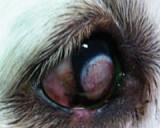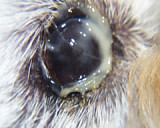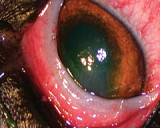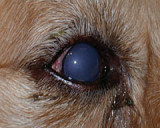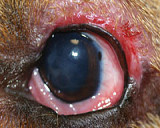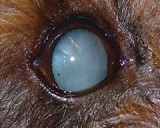Eosinophilic keratitis is a characterized by the formation of white, almost cottage cheese like lesions on the cornea and or conjunctiva in cats. As its name suggests these lesions are composed of eosinophils.
These lesions usually develops after an episode of Feline Herpes Virus induced keratitis or conjunctivitis. However with some cats there is no history of viral problems. In these cases, eosinophilic keratitis or conjunctivitis can be considered to be an allergic reaction, some suggesting to a fish based diet or mosquito bites.
These characteristic white lesions are composed of eosinophils. A diagnosis can easily confirmed by cytology (apply topical anaesthetic, gently scrape the plaques with a cotton tip, dab onto a slide and apply Diff Quik stain).


Many text books suggest topical and or oral cortisone to treat this problem. However many cases are secondary to viral keratitis caused by Feline Herpes Virus. Cortisone therapy can often reactivate the viral infection. Topical cortisone should be used with caution, and then only in cases that have no history of prior viral keratitis. Owners should be instructed to watch the treated eye for any signs of irritation which might suggest a reactivation of the viral infection.
Our preferred treatment in most cases is topical ciclosporine ointment (Optimmune). This drug seems to work well in most cases, with few side effects. However prolonged treatment is often required.
Megoestrol acetate therapy (Ovarid) has also been used to treat this condition. These days this drug with its potential side effects of inducing diabetes and mammary tumours is rarely used. We have found this therapeutic option to be very effective in refractory cases or in cats that are difficult to treat topically. We have found low doses of Ovarid for less than 2 weeks can be effective.
In some cases the Eosinophilic reaction can develop in the conjunctiva. In these cases there may be thickening and redness of the conjunctiva and the presence of white plaques. These also respond to treatments described previously.
Beware of dry eye in with eosinophilic keratoconjunctivitis.
